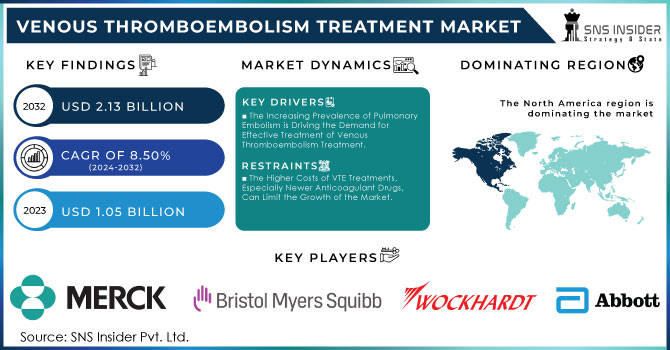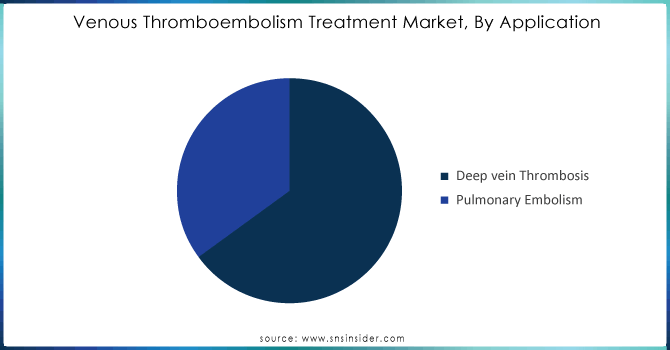Venous Thromboembolism Treatment Market Report Scope & Overview:
The Venous Thromboembolism Treatment Market Size was valued at USD 1.13 Bn in 2024, and is expected to reach USD 2.13 Bn by 2032, and grow at a CAGR of 8.50% Over the Forecast Period of 2025-2032.

Get More Information on Venous Thromboembolism Treatment Market - Request Sample Report
The venous thromboembolism treatment market is developing gradually. Various factors make this phenomenon occur: increased attention campaigns and technological progress. The Centers for Disease Control and Prevention provide information on the VTE issue in the United States. 60,000-100,000 people die from VTE in the U.S. every year. Preventative and early treatment measures should be taken. Increased attention campaigns are noteworthy as well. The appropriate assistance can be performed when people are aware of the symptoms and predisposition to VTE. The government and healthcare institutions work on the development of educational programs to decrease the number of VTE incidents and improve case management. Technological progress is important for the VTE market treatment, too.
The range of imaging devices is expanded. As far as imaging devices are concerned, the picture resolution is increased while the diagnostic kit is developed. Computer tomography and ultrasound technologies are now available. The technology has proved to be superior in the diagnosis of deep vein thrombosis and pulmonary embolism and in taking measures. According to the American Heart Association, diagnostic time is reduced and, thus, treatment can be started earlier. A good prognosis is achieved in this case. Finally, the VTE treatment market becomes profitable because of the possibilities emerging markets are now able to uncover. Asia-Pacific, Latin America, and Eastern Europe can make the market profitable. The economic growth in those regions is reflected in increased health expenditures. The adoption of expensive and advanced treatment and preventative measures has become possible due to the information campaigns carried out in the countries.
Market Size and Forecast:
-
Market Size in 2024 USD 1.13 Billion
-
Market Size by 2032 USD 2.13 Billion
-
CAGR of 8.50% From 2025 to 2032
-
Base Year 2024
-
Forecast Period 2025-2032
-
Historical Data 2021-2023
Venous Thromboembolism Treatment Market Trends:
-
Rising prevalence of pulmonary embolism is significantly boosting the demand for advanced venous thromboembolism (VTE) treatment solutions.
-
Increasing cancer incidence is driving higher adoption of effective anticoagulant therapies and supportive treatment options for VTE management.
-
Growing awareness campaigns and educational initiatives are promoting early diagnosis and timely intervention for venous thromboembolism.
-
Technological advancements in diagnostic imaging and biomarkers are enabling faster and more accurate detection of VTE cases.
-
Expanding healthcare infrastructure in emerging markets, coupled with rising healthcare expenditure, is creating new growth opportunities for VTE treatment adoption
Venous Thromboembolism Treatment Market Growth Drivers:
The rising prevalence of pulmonary embolism and the growing incidence of cancer are major factors driving demand for effective venous thromboembolism (VTE) treatment. Both conditions significantly increase the risk of VTE, highlighting the urgent need for advanced therapies and comprehensive care strategies to improve patient outcomes and reduce complications.
Venous Thromboembolism Treatment Market Restraints:
The high costs of venous thromboembolism (VTE) treatments, particularly newer anticoagulant drugs, pose a challenge to market growth. While anticoagulants remain effective in managing and preventing VTE, their significant risk of bleeding complications restricts widespread adoption, creating barriers for patients and limiting the overall expansion of the treatment market.
Venous Thromboembolism Treatment Market Opportunities
Increasing awareness campaigns and advancements in diagnostic technologies are enabling earlier detection and treatment of venous thromboembolism (VTE). At the same time, emerging markets offer substantial growth opportunities, supported by improving healthcare infrastructure, rising healthcare expenditures, and growing awareness, driving greater accessibility and adoption of effective VTE treatment solutions worldwide..
Venous Thromboembolism Treatment Market Segment Analysis:
By Device
Compression systems are widely used for managing venous thromboembolism. In 2024, they were the leading devices in the VTE segment, occupying around 35% of the total market share. This product is favored for its high efficiency, comfort, and significant role in preventing deep vein thrombosis and its complications, especially in high-risk patients. Compression systems, which include pneumatic compression devices and graduated compression stockings, are widely used in both hospital and outpatient settings. The controlled pressure, oscillation, or pressing of the legs enhances blood flow, reducing the risk of clot formation. The method is used for patients who undergo surgery, experience extended periods of immobility, or have chronic venous insufficiency.
The non-invasive nature and simplicity of use are the most important reasons for the high adoption rate of this VTE management device. The device gently presses the legs, encouraging blood flow. The significant amount of evidence supporting the necessity and effectiveness of the method for preventing VTE cannot be ignored. As a result, the National Center for Biotechnology Information includes compression therapy in VTE prevention guidelines.
By Application
Deep vein thrombosis in the context of venous thromboembolism treatment is the largest of all application areas. The venous thromboembolism treatment market share was 68% in 2024, which can be interpreted by the fact that DVT is far and away the leading VTE diagnosis. The symptoms of DVT often cloud with those of PE, but CDC data shows that DVT affects approximately 1 in 1,000 adults in the United States each year. At any rate, it has to be admitted that PE may be severe, but it is far less common, which results in a smaller market share of this health problem.
The leading place of the DVT application segment is easily explained by the high prevalence of the given condition and the increasing number of new advanced treatment solutions such as novel anticoagulants and various mechanical devices. As of 2023, the vast majority of this market depends on DVT. It is maintained not only by the high rates of incidences but also by the increasing need for the efficient management of the condition.

Need any customization research on Venous Thromboembolism Treatment Market - Enquiry Now
Venous Thromboembolism Treatment Market Regional Analysis:
North America Venous Thromboembolism Treatment Market Insights
In 2024, North America was the largest regional venous thromboembolism treatment market, taking advantage of a leading share of 40% for several reasons. First, this region’s dominance in the market is reinforced by the advanced healthcare infrastructure and highly developed medical reimbursement facilities that enhance both the availability and affordability of VTE treatments. As reported by the Centers for Medicare & Medicaid Services, the U.S. healthcare system, in particular, benefits from extensive coverage and support provided to innovative medical technologies, and their consequent adoption to improve VTE treatment. Second, the advanced level of technological development in North America and the focus on research in the medical field have resulted in the creation of a wide range of state-of-the-art therapies and devices to manage VTE.
Asia Pacific Venous Thromboembolism Treatment Market Insights
Asia Pacific, in turn, is also rapidly growing but did not surpass North America in market size in 2024, at present, it is projected to become the fastest-growing regional market. Specifically, population growth, as well as the rise in consumer awareness of VTE and the government’s intention to support healthcare access and quality, would contribute to a swift increase in demand. This increase will be fueled by the modernization of healthcare infrastructure and the growth of medical tourism in China, India, and other developing countries. In these countries, further government initiatives and financial investments are expected to further improve the availability of VTE treatments, making the Asia Pacific a substantial, fast-growing market shortly.
Europe Venous Thromboembolism Treatment Market Insights
Europe represents a mature market for venous thromboembolism (VTE) treatment, supported by advanced healthcare systems, strong government initiatives, and a high prevalence of cardiovascular and cancer-related conditions. The region emphasizes early diagnosis, adoption of novel anticoagulants, and comprehensive patient care, with ongoing investments in clinical research and digital healthcare solutions strengthening treatment accessibility and outcomes.
Latin America (LATAM) and Middle East & Africa (MEA) Venous Thromboembolism Treatment Market Insights
The LATAM and MEA venous thromboembolism (VTE) treatment markets are expanding due to rising healthcare investments, growing awareness campaigns, and improving access to diagnostic and therapeutic solutions. Increasing incidence of chronic diseases and urban lifestyle changes drive demand. However, cost barriers and uneven healthcare infrastructure present challenges, creating opportunities for affordable therapies and collaborations with global pharmaceutical companies.

Venous Thromboembolism Treatment Market Key Players:
- Merck & Co
- Bristol-Myers Squibb Company
- Bio Compression Systems, Inc.
- Upsher-Smith Laboratories, Inc.
- Wockhardt Ltd
- Dupont Pharm Co
- Bayer AG
- Abbott Laboratories
- Pfizer Inc
- Boehringer Ingelheim GmbH
- Sanofi S.A.
- Daiichi Sankyo Company, Limited
- Johnson & Johnson (Janssen Pharmaceuticals)
- Novartis AG
- Eli Lilly and Company
- Aspen Pharmacare Holdings Limited
- GlaxoSmithKline plc (GSK)
- Portola Pharmaceuticals, Inc. (Alexion Pharmaceuticals)
- Alnylam Pharmaceuticals, Inc.
- Anthos Therapeutics, Inc.
Competitive Landscape for Venous Thromboembolism Treatment Market:
-
The CIRSE 2022 annual meeting, which took place in Barcelona, Spain, on September 10-14 was dedicated to Pulmonary Embolism and Deep Vein Thrombosis.
| Report Attributes | Details |
|---|---|
| Market Size in 2024 | USD 1.13 Billion |
| Market Size by 2032 | USD 2.13 Billion |
| CAGR | CAGR of 8.50% From 2025 to 2032 |
| Base Year | 2024 |
| Forecast Period | 2025-2032 |
| Historical Data | 2021-2023 |
| Report Scope & Coverage | Market Size, Segments Analysis, Competitive Landscape, Regional Analysis, DROC & SWOT Analysis, Forecast Outlook |
| Key Segments | • By Device (Compression System, Thrombectomy Systems, IVC Filters, Stockings & Others) • By Application (Deep Vein Thrombosis & Pulmonary Embolism) • By End-use (Hospitals, Catheterization Laboratories & Others) |
| Regional Analysis/Coverage | North America (US, Canada), Europe (Germany, UK, France, Italy, Spain, Russia, Poland, Rest of Europe), Asia Pacific (China, India, Japan, South Korea, Australia, ASEAN Countries, Rest of Asia Pacific), Middle East & Africa (UAE, Saudi Arabia, Qatar, South Africa, Rest of Middle East & Africa), Latin America (Brazil, Argentina, Mexico, Colombia, Rest of Latin America). |
| Company Profiles | Merck & Co, Bristol-Myers Squibb Company, Bio Compression Systems, Inc., Upsher-Smith Laboratories, Inc., Wockhardt Ltd, Dupont Pharm Co, Bayer AG, Abbott Laboratories, Pfizer Inc, Boehringer Ingelheim GmbH |

